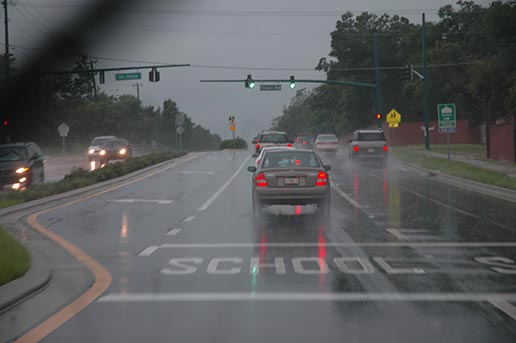Tips for Driving in the Rain

Because the roads can be very slippery, you need to exercise caution in the rain.
Be the Best Driver on a Rainy Day
Rain is a good thing: it helps water our plants, it can be fun to frolic in; but driving in it? That’s not so fun. In fact, it can be downright dangerous. Read on to know what you should do when it’s really coming down out there.
Why Is Rain So Dangerous to Drive In?
Rain actually causes your tires to lose traction—when the road gets wet, the water mixes with the dirt on the asphalt, making it harder for your tires to “hang on” to the road. Simply put, rain makes everything slippery, and puddles that form can lead to hydroplaning. Apart from what the precipitation does to the road and your car, the rain makes it difficult to see. We’ve all been there: you’re driving along and all of a sudden the downpour becomes so thick that it’s hard to see where you’re going.
TIPS AND TECHNIQUES
Plan for More Time on the Road
When it’s raining, even if it’s not that much, traffic tends to move slower (drivers in California are all too familiar with this). And though it may slow you down on your commute to school or work, this is a good thing: you should drive slower in the rain. Always give yourself plenty of time (this means allowing extra time) to get to your destination. Never rush when it’s raining heavily: accidents are even more likely when weather conditions are poor.
Be More Cautious with Braking
When you’re driving in a downpour, you simply cannot brake late the way you can in ideal weather conditions. The roads are slippery, which means you could slide more if you brake too quickly. There’s also a chance that you could get water in your brakes, which will cause them to lose their stopping power. You want to avoid slamming on your brakes—when it’s raining, you should brake with less force. So be sure to keep plenty of distance between you and the car in front of you to avoid any of these situations. As you may recall from Drivers Ed, the following distance in ideal conditions is three seconds—increase that distance to 4 seconds or more in the rain, depending on the situation.
Use Your Headlights
Even if it’s only lightly sprinkling, your headlights will help you see the road better. Plus, having your headlights on allows other drivers to see you. However, contrary to what you may think, using your high-beam headlights will actually make things worse: the light from the beams will reflect back at you off the water in the air, actually making it harder for you to see.
Do Not Use Cruise Control
While you may think having your car travel at a set speed when it’s raining is a good idea, cruise control can actually become problematic when it’s raining. If your car hydroplanes while you have your cruise control set, your car can actually accelerate—which is not something you want to happen when you’re hydroplaning. Having your foot away from the pedals can also be hazardous when you are driving in torrential rain.
Be Extra Careful After Long Dry Spells
If it’s raining hard after a long period of dryness, you need to be even more cautious on the road. Over time, engine oil and other substances build up on streets, and when rainwater gets added to the mix, a very slippery combination results. The first few hours of that initial rain are the most treacherous. Eventually, the rain washes away the buildup on the streets, but until then, be wary when driving anywhere.
Avoid Standing Water
Staying away from standing water (like large puddles) is the best-case scenario, but if you approach it on the roadway and must drive through it, be sure you slow down. If you don’t, you risk hydroplaning and losing control of your car. Plus, passing through deep water could spell trouble for your car’s engine and brakes.
Stay Off the Road If Possible
Of course, the best thing is to stay at home when there’s a rainstorm. Obviously this isn’t always possible, with school, work, and other obligations, but if you can stay off the road, do so. There’s no sense risking an accident if you don’t have to.










